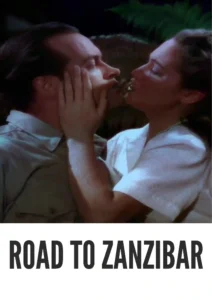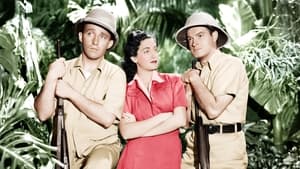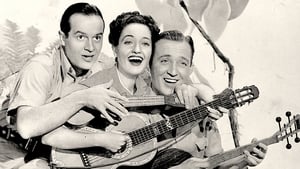Video Sources 0 Views

Synopsis
Exotic Escapades and Hilarious Hijinks: Road to Zanzibar (1941) in Vibrant Color

Embark on a side-splitting journey with Road to Zanzibar, a classic comedy adventure from 1941, now beautifully colorized for a revitalized viewing experience. Starring Bing Crosby and Bob Hope, this film is a delightful blend of musical numbers, slapstick, and exotic locales. Perfect for fans of classic Hollywood and those seeking light-hearted entertainment, this HD download brings a beloved piece of cinematic history to your screen. Also known as Bob Hope and Bing Crosby in Road to Zanzibar.
Road to Zanzibar Storyline: A Tangled Web of Adventure and Comedy
Road to Zanzibar follows the misadventures of Chuck Reardon (Bing Crosby) and Hubert “Fearless” Frazier (Bob Hope), two con men who find themselves in a series of hilarious situations in Zanzibar.When they accidentally burn down a circus, Chuck and Hubert flee to Zanzibar to escape the authorities. Along the way, they encounter a variety of colorful characters, including two beautiful women, Donna Latour and Julia Quimby, who become entangled in their schemes. As they navigate the local culture and try to make a quick buck, Chuck and Hubert find themselves in increasingly absurd and dangerous situations. From battling lions to impersonating big-game hunters, their escapades are filled with slapstick humor and witty banter. Ultimately, Road to Zanzibar is a rollicking comedy that showcases the comedic talents of Crosby and Hope.
Movie Cast
The film features a talented cast of actors who bring this comedic story to life:
- Bing Crosby as Chuck Reardon
- Bob Hope as Hubert “Fearless” Frazier
- Dorothy Lamour as Donna Latour
- Una Merkel as Julia Quimby
- Eric Blore as Charles Kimble
Movie Genre
Road to Zanzibar falls into the genre of screwball comedy adventure, with elements of musical and romantic comedy. Its lighthearted tone, exotic setting, and comedic set-pieces make it a delightful and entertaining film.
Historical Context: The “Road to…” Series and Wartime Entertainment
Released in 1941, Road to Zanzibar was the second film in the highly successful “Road to…” series starring Bing Crosby and Bob Hope. These films were known for their blend of comedy, music, and exotic locales, providing audiences with a much-needed escape from the realities of World War II. The “Road to…” series became a cultural phenomenon, solidifying Crosby and Hope’s status as two of Hollywood’s biggest stars.
Colorization Details
This colorized version of Road to Zanzibar has been meticulously restored using modern digital techniques, enhancing the visual appeal while preserving the film’s original charm. The colorization process involved carefully analyzing the grayscale tones of the original black and white footage and assigning appropriate colors to each scene. While the specific software used remains proprietary, the techniques employed included advanced algorithms for color palette selection and image enhancement. This painstaking process brings new life to the characters and settings, making the story even more engaging for modern audiences. While some may debate the merits of colorizing classic films, it introduces these films to a broader audience, ensuring their legacy for future generations.
Technical Details
- Director: Victor Schertzinger
- Screenplay: Frank Butler, Don Hartman
- Story by: Frank Butler, Don Hartman
- Cinematography: Ted Tetzlaff
- Edited by: Alma Macrorie
- Production Company: Paramount Pictures
- Distributed by: Paramount Pictures
- Runtime: 92 minutes
Technical Specifications
- Download Format: MP4
- Resolution: HD (1080p)
- Compatibility: Compatible with most devices, including smartphones, tablets, computers, and smart TVs.
Reviews and Critical Reception
Road to Zanzibar (1941) is celebrated as one of the most entertaining entries in the “Road to…” series, showcasing the comedic chemistry between Bing Crosby and Bob Hope. Its blend of slapstick, musical numbers, and exotic adventure has made it a beloved classic for generations. As a prime example of classic Hollywood comedy, Road to Zanzibar offers a delightful escape into a world of laughter and adventure.
FAQs
- Q: What is Road to Zanzibar about?
- A: Road to Zanzibar is a comedy adventure about two con men who find themselves in a series of hilarious situations in Zanzibar.
- Q: Is Road to Zanzibar (1941) part of the “Road to…” series?
- A: Yes, Road to Zanzibar is the second film in the highly successful “Road to…” series starring Bing Crosby and Bob Hope.
- Q: Is this version of Road to Zanzibar colorized?
- A: Yes, this version has been professionally colorized to enhance the viewing experience.
- Q: What makes Road to Zanzibar interesting for classic film fans?
- A: Road to Zanzibar showcases the comedic talents of Bing Crosby and Bob Hope and offers a delightful escape into a world of laughter and adventure.
- Q: What is the download format?
- A: The download format is MP4, which is compatible with most devices.
- Q: What resolution is the download?
- A: The resolution is HD (1080p), providing a high-quality viewing experience.
Download Now in HD!
Watch Road to Zanzibar Today!














